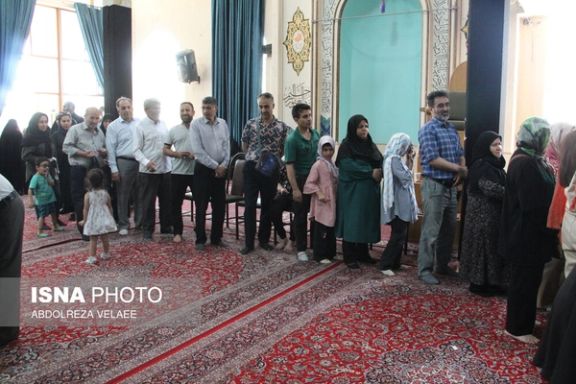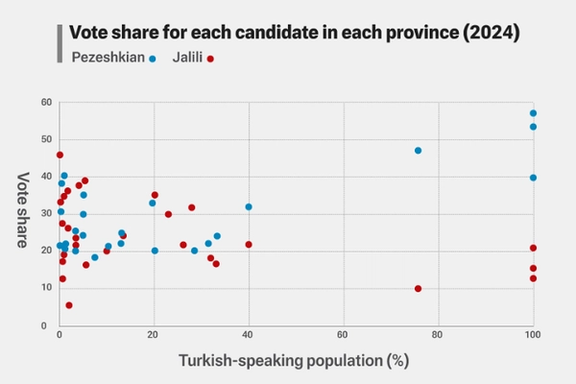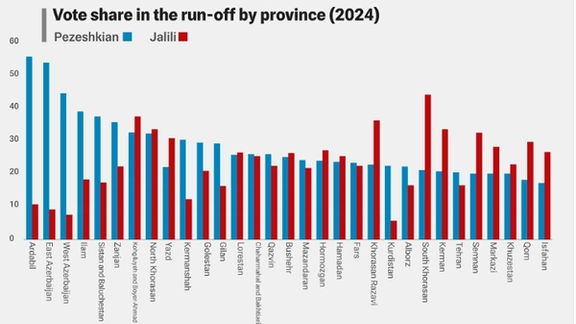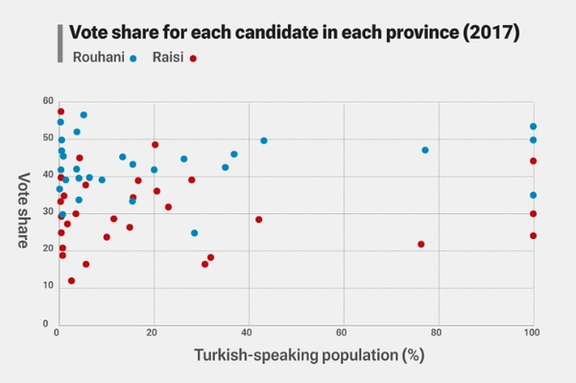Did the ethnic vote determine Iran’s new President?

Masoud Pezeshkian is now officially Iran’s president. He was sworn in on Tuesday, having won the election after two rounds, both record-setters for low turnout (39.9% and 49.7% respectively).

Masoud Pezeshkian is now officially Iran’s president. He was sworn in on Tuesday, having won the election after two rounds, both record-setters for low turnout (39.9% and 49.7% respectively).
In the second round, Pezeshkian’s campaign depicted his hardline rival as an existential threat to the livelihood of the nation. More people turned out for the run-off and Pezeshkian defeated the ultra-conservative Saeed Jalili. But he lost to those who boycotted the election. In the end, many more stayed at home than voted for the ‘reformist’ candidate.
So, the question is: how did Pezeshkian win despite failing to persuade the majority that he could deliver the reforms he promised? The answer, I argue in this piece, is the ethnic vote. (All data featured in this piece comes from official sources, and there are reasons to doubt their veracity. But that would be the subject for another article).
Ethnically, Iran is a highly diverse society. While the official language is Persian, millions of people have different mother tongues, such as Azari, Kurdish, Baluchi, and Arabic. These minorities often lack representation, particularly many Kurds and almost all Baluchis who are Sunnis, whereas most other groups, including the Arabic and Azeri speakers, are Shia.
Pezeshkian seems to come from a Azeri-speaking family, but he was born and raised among Kurds. Most minorities, ethnic and religious, picked him over Jalili, especially the Baluchis and the Kurds. But the focus here is on the Azari-speaking voters. (Note that most Turkish-speaking Iranians are Shia, which helps us single out the ethnic element.)
The figure below illustrates the role of the Azari speakers in Pezeshkian's victory. The horizontal axis represents the ratio of Azari speakers in each province. Azari belongs to the family of Turkic languages, which is also heavily influenced by Persian. Within Iran, people usually call it “Torki”, which means Turkish. The vertical axis represents the vote shares in the run-off, as a percentage of eligible voters in each province.

To better understand what seems to be a strong ethnic factor, we can consult the chart below, which shows the Azari or Turkish speaking population in each province.
Pezeshkian secured the highest share of vote in such provinces as East Azerbaijan, West Azerbaijan, Zanjan and Ardabil, where the majority are Azari (Turkish) speakers. In contrast, Jalili had an overall advantage in provinces with the lowest Azari-speaking populations. This does not mean that Jalili is popular among Persian-speaking Iranians. It seems to suggest that he did better than Pezeshkian in provinces with minimal ethnic minority presence.

The quantitative index of the Pearson Correlation Coefficient (PCC) is illuminating in this regard. The PCC index indicates the strength of the linear relationship and dependency between two variables. In the following diagram, each candidate’s vote share (in each province) is the dependent variable, and the relative size of the Turkish-speaking population (in that province) is the independent variable.
The correlation coefficient for Pezeshkian is 0.7 (70%), while for Jalili it is -0.47 ( -47). A positive value indicates that an increase in the independent variable leads to an increase in the dependent variable, whereas a negative value suggests that an increase in one variable results in a decrease in the other. The linear relationship for Pezeshkian's votes is strong and positive, suggesting that his share of vote (in most cases) rises as the Azari speaking population in a province increases. In contrast, the relationship for Jalili is weak and negative. (Same for Kurdish, Baloch, and Turkmen speakers).
One counterargument could be that the data should be interpreted differently: that the Persian-speaking population didn’t like Pezeshkian and voted for Jalili. But the low turnout in such provinces seem to refute this hypothesis. Moreover, in most of these provinces, Pezeshkian gained more in vote share as the turnout rose in the run-off.

To underline the crucial role of the Azari (Turkish) speaking Iranians in the second round of the election, we can compare the results with that of the 2017 presidential election –where Hassan Rouhani tried to attract the ethnic vote.

As seen above, Rouhani’s vote is more homogeneous across provinces, and the ‘Azari variable’ is less pronounced. Rouhani did receive more votes in provinces with majority Azari-speaking populations. But he also did so in the non-ethnic regions (except for Zanjan, where Raisi had more votes.)
The Pearson correlation coefficient for Rouhani is 5%, while for Raisi it is -10%. This indicates that the strength of the linear relationship between the two variables is much weaker. Azari speaking Iranians didn’t like Raisi, but their preference had much less impact on the final result that it did in 2024. It was insignificant statistically.
In the 2024 run-off, if we look at the Azari speaking provinces only, Pezeshkian got 2.8 million more votes than Jalili. That’s almost a million more than their vote difference in the first round. However, if we look at the six provinces where Persian is predominant, Jalili got about 830,000 more votes than Pezeshkian. In the first round, that number was about 275,000. In other words, the increase in the vote margin between Pezeshkian and Jalili in the second round is 3.7 times greater than the change observed in the six other provinces. Jalili’s advantage in Isfahan can be attributed to the low turnout (less than 50%). In Yazd, and Kerman, where official turnout in the run-off was above 50%, the changes may suggest a dramatic decline in the social standing of the reformists. In Khorasan Razavi, Jalili’s success may be due to local connections (he was born there). His lead (551,000 votes) is notably large and unexpected. In 2017, the picture was markedly different. Rouhani's advantage over Raisi in the six provinces mentioned above was 2.2 times greater than that of the four provinces with Azari speaking majorities.
Pezeshkian’s campaign may depict his presidency as a ‘reformist’ triumph. Previous ‘reform’ moments (1997, 2001, 2013, and 2017) were marked by national fervor and high turnout, neither of which transpired in 2024. Pezeshkian may name a few ‘reformists’ to his cabinet, and some may even call his administration a ‘reform government.’ The president himself acknowledges his indebtedness to Supreme Leader Ali Khamenei. However, the real story of Iran’s 2024 elections may very well be the ethnic vote.